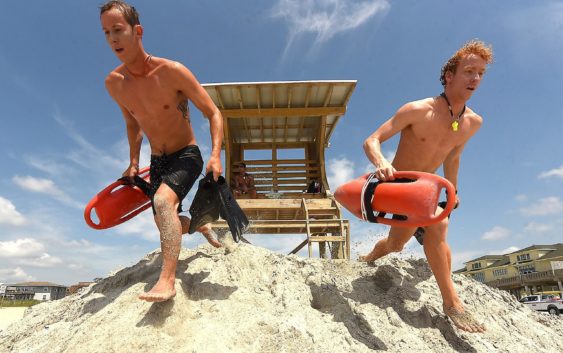- Sellers and Rantanen are among the NHL trade deadline winners. Hurricanes and Boeser are some losers
- Hurricane forecasters express concern over NOAA job cuts impact
- FEMA deadline for Hurricane Helene recovery aid extended again
- Tornado drills to take place at schools across North Carolina Friday morning
- Hays County emergency alerts cause confusion during Tuesday's wildfires
Warning for beach-goers: Rip currents from Hurricane Isaias could be deadly

An often-invisible killer could be lurking — and it’s not sharks
WILMINGTON — To the untrained eye, rip currents basically are invisible. Even worse, the narrow channels of fast-moving water often look like a calm area in an otherwise rough surf and are difficult to spot at eye level.
In contrast to the breaking waves and white surf on either side, rip currents can look flat. As waves break on sandbars, rip currents form when water runs powerfully between them back out to sea, sometimes carrying swimmers with it.
Hurricane Isaias is expected to move up the southeast coast over the weekend, though its path remains uncertain. But forecasters with the National Weather Service in Wilmington are sure about one thing — the rip current threat locally is already increasing and will continue to increase into Monday.
Rip currents once were invisible — or mostly out of mind — for JoAnn and Gary Swart and their family. That changed one tragic day in May 2002 when their 22-year-old daughter Crystal Swart drowned in a rip current at Wrightsville Beach.
As the Swarts grieved, they also were determined to learn more about rip currents. The Castle Hayne couple soon realized that if Crystal had known what to do, she very well could have survived. For nearly 18 years now, the Swarts have pushed for more awareness of rip currents and more widespread education on how to survive them.
Obviously, the best way to survive a rip current is to stay out of the water when they are prevalent. Ocean lifeguards are trained to spot rip currents and use the higher vantage point of their stands to identify them. If there are rip currents in a guarded area, lifeguards will post a red flag. When a red flag goes up, stay out of the water or stay in a very shallow area. Lifeguards can offer advice on whether you should go in at all.
If lifeguards are not present and rip current warnings have been issued, water-safety experts say follow this rule: “If in doubt, do not go out.”
At Wrigthsville Beach, Fire Chief Glen Rogers minced no words about what his ocean rescue squad means when they post a red flag.
“When red flags are up, the recommendation is to not go in the water,” Rogers said Friday, which he said so far had been a beautiful day with no more rip currents than they might usually expect to see.
Wrightsville Beach officials are expecting the biggest impact from the storm Sunday and Monday, with the number of rip currents depending on the path the storm ultimately takes.
In a sense, Rogers said, bad weather on those days might actually help with water safety, at least in terms of the number of people at risk.
“When the weather gets lousy there are very few people on the beach,” Rogers said.
If you do get caught in a rip current, try not to panic — rip currents don’t pull you under, they pull you out. Even strong swimmers can’t go against the current, so the best method is to swim parallel to the shoreline until you no longer are being pulled out.
The U.S. Lifesaving Association suggests swimming toward breaking waves — those areas should be out of the rip. At that point, it will be easier to get back to shore. If you can’t swim parallel to the shore, try to float or tread water and draw attention to yourself.
Rip currents can be deadly for swimmers caught in them and often turn deadly for those who try to help. The best option is to get help from a lifeguard or call 911, according to the U.S. Lifesaving Association. Then, try to direct the person caught in the rip current to swim parallel to the shoreline. If possible, throw them something that floats.
“Be alert. Enjoy the beach and wonderful Wrightsville,” Rogers said Friday. “(But) as always be cautious in the water and swim near a lifeguard.”
How to survive a rip current
(according to the U.S. Lifesaving Association)
First, try to relax. Rip currents don’t pull you under.
Don’t swim against the current.
You may be able to escape by swimming out of the current in a direction following the shoreline, or toward breaking waves, then at an angle toward the beach.
You may be able to escape by floating or treading water if the current circulates back toward shore.
If you feel you will be unable to reach shore, draw attention to yourself. If you need help, yell and wave for assistance.
— U.S. Lifesaving Association
Reporter Scott Nunn can be reached at 910-343-2272 or Scott.Nunn@StarNewsOnline.com.